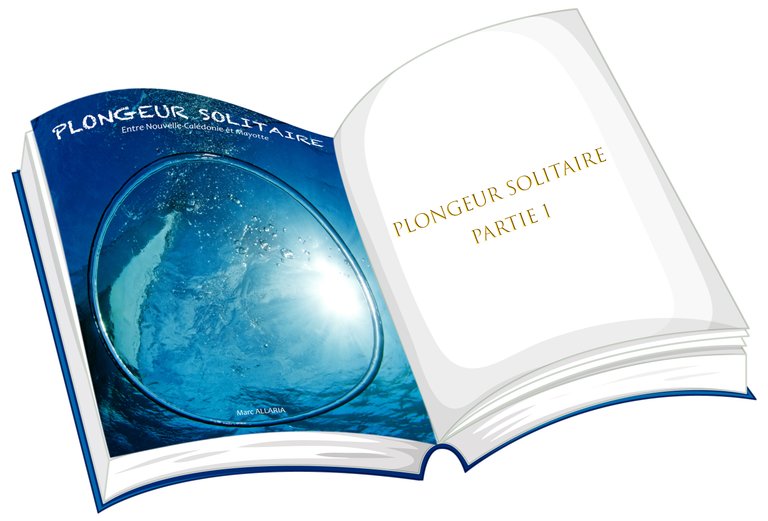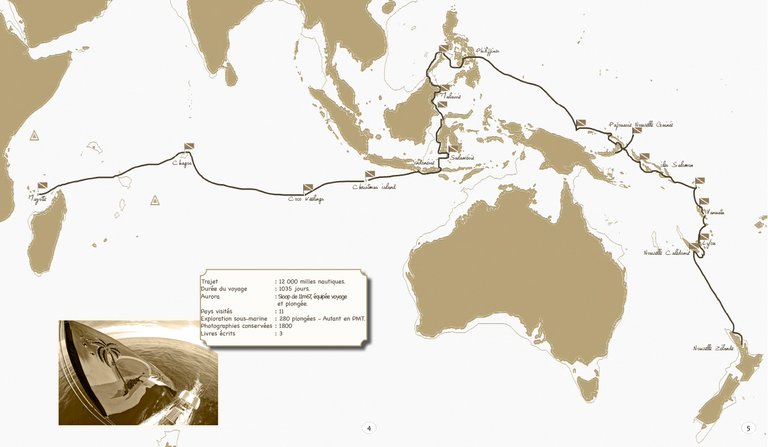PLONGEUR SOLITAIRE - THE BOOK - Part 1 (Français/Anglais)
(Edited)

Nous sommes en 1957. L’équipage du Moana rentre en France après 3 années d’exploration sous-marine à travers le globe. Dans leur sillage, des îles qui leur étaient jusqu’alors inconnues, des gens qui ne parlaient pas leur langue, et des rencontres sous-marines inscrites à vie dans leurs mémoires. Dans les calles du voilier, des fusils de chasse sous-marine certainement utilisés bien plus que de raison, mais aussi les premières caméras et appareils photos sous-marins. Ils ramèneront de leur voyage des images d’un monde encore méconnu de tous, qui feront rêver et s’étonner les milliers de personnes venus accueillir ces héros sur les quais tropéziens. Pendant la même période, un autre équipage, celui de La Calypso appareille sous les ordres du commandant Cousteau. Avec à son bord un équipement bien plus moderne et une diffusion télévisée efficace, l’équipe du commandant fera rêver des millions de télespectateurs découvrant un monde qui a désormais un nom : « Le monde du silence ». Si ces deux équipes disposaient de toute évidence de moyens différents pour la mise en œuvre de leur entreprise, les hommes, eux, étaient animés de la même et unique passion : L’exploration sous-marine.
Mais qu’est-ce que l’exploration sous-marine ? L’industrialisation récente de la plongée sous-marine a quelque peu faussé la définition d’un terme désormais utilisé pour différencier la plongée d’enseignement de la plongée “promenade”. Mais explorer, c’est avant tout se rendre dans un lieu peu ou pas fréquenté de l’Homme, en général un site isolé géographiquement. L’exploration sous-marine commencerait donc par de la navigation. Plus exactement, elle commence par de l’avitaillement, de la préparation, et de l’étude de cartes. Le bateau est paré, il faut maintenant se lancer vers un point de chute dont on ne connaît rien ou presque. La navigation est alors à l’honneur, et ajoute à l’équation quelques variables telles que les vents, les courants, l’entretien du matériel, et la gestion d’un milieu sur lequel l’Homme n’est qu’un invité temporaire : La Mer.
Et puis le bateau arrive à « bon port », un lieu souvent habité par une population locale ne parlant pas la même langue que le visiteur et qu’il sera courtois de rencontrer. Demander les autorisations adéquates, partir à la « pêche » aux informations, font partis des étapes obligatoires de l’exploration sous-marine, et donnent l’occasion de rencontres ô combien riches culturellement. Les habitants de tous ces villages isolés offrent bien souvent au voyageur un accueil et une aide précieuse sans lesquels le projet tout entier pourrait se voir remis en question.
Le temps de la plongée arrive alors. Un temps débordant d’émotion devant la rencontre imprévue avec un requin baleine, un temps où l’on peut s’entendre respirer devant le balai de quelques raies manta, un temps où l’on s’interroge sur les intentions d’un requin que l’on se force à croire inoffensif, un temps où le cœur s’emballe devant une épave dont on pense en être le découvreur, mais finalement, un temps bien plus court que tout le travail périphérique entourant l’activité. Là est l’exploration sous-marine.
Il est évident que l’histoire racontée dans ce récit ainsi que le travail photographique réalisé, n’est comparable en aucun point aux aventures vécues par Le Moana ou aux projets développés par La Calypso. Mais ces derniers ont certainement inspiré le rêveur que je suis a réunir toute ma force et mon entêtement pour mettre en application une philosophie de vie à laquelle je pense depuis bien des années, et qui au travers d’un voyage de près de 3 ans, m’aura ramené vers une île devenue indispensable à mon existence: Mayotte.
Ce livre en est le témoignage...
A suivre...
We are in 1957. The crew of the Moana returns to France after 3 years of underwater exploration around the world. In their wake, islands that were previously unknown to them, people who did not speak their language, and underwater encounters recorded for life in their memories. In the streets of the sailboat, underwater hunting guns certainly used much more than reason, but also the first cameras and underwater cameras. They will bring back from their trip images of a world still unknown to all, which will make dream and be amazed the thousands of people who came to welcome these heroes on the docks tropéziens. During the same period, another crew, that of La Calypso sails under the orders of the commander Cousteau. With much more modern equipment and effective television broadcasting, the commander’s team will make millions of viewers dream about discovering a world that now has a name: «The world of silence». While these two teams obviously had different means to implement their business, the men were driven by the same and unique passion: underwater exploration.
But what is underwater exploration? The recent industrialization of scuba diving has somewhat skewed the definition of a term now used to differentiate teaching diving from “walking” diving. But to explore is first and foremost to go to a place little or not frequented by humans, usually a geographically isolated site. Underwater exploration would therefore begin with navigation. More precisely, it begins with the resupply, preparation and study of maps. The boat is ready, we must now launch to a drop point of which we know nothing or almost. Navigation is then in the spotlight, and adds to the equation some variables such as winds, currents, maintenance of equipment, and management of an environment on which man is only a temporary guest: The Sea.
And then the boat arrives at destination, a place often inhabited by local people who do not speak the same language as the visitor and whom he will be courteous to meet. Ask for proper permissions, go fishing for information, are part of the mandatory stages of underwater exploration, and provide the opportunity for culturally rich encounters. The inhabitants of all these remote villages often offer the traveller a welcome and valuable help without which the whole project could be called into question.
The time for diving comes then. A time full of emotion before the unexpected encounter with a whale shark, a time when we can hear ourselves breathing in front of the broom of some manta rays, a time when we wonder about the intentions of a shark that we force to believe harmless, a time when the heart is racing in front of a wreck that we think is the discoverer, but ultimately, a much shorter time than all the peripheral work surrounding the activity. There is underwater exploration.
It is obvious that the story told in this story and the photographic work done, is not comparable in any point to the adventures lived by Le Moana or the projects developed by La Calypso. But these have certainly inspired the dreamer that I am to bring together all my strength and stubbornness to implement a philosophy of life which I have been thinking about for many years, and which through a trip of almost 3 years, will have brought me back to an island that has become indispensable for my existence: Mayotte.
This book is the testimony...
To be continued...

How to follow me ?
On Instagram here
On my website
On Facebook here
0
0
0.000
!PIZZA
Bonne lecture à tous.
Et succès à toi.
Your post has been manually reviewed for curation by the Principality of Bastion.
Check the Trail of posts we voted
Principality of Bastion - Our Leit Motiv? Let's Grow Together.
Principality's site | Minava NFT Market | Discord | Our Twitch Channel
You may TRAIL this account if you like the curation we do, or join our discord to know more about what we do.

$PIZZA slices delivered:
@itharagaian(4/10) tipped @marc-allaria
Come get MOONed!
To be continued...
Oui !!! Ce n'est que la préface. Le reste arrivera un peu chaque semaine. Je savais que ça allait t'attirer!
Si tu veux les traduire, dis moi, ça m'évitera les coquilles... (Moi je laisse google traduction faire pour l'instant)
Non, on ne peut plus juste traduire les posts, autrement HiveWatchers te tombent dessus. Lorsqu'on fait une traduction, il faut mettre au moins 50% de contenu original.
Ah bon ! Je n'arrive toujours pas à comprendre en quoi ils font du bien à Hive... Désolé, je vais continuer avec les traducteurs en ligne.